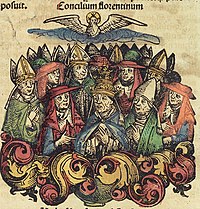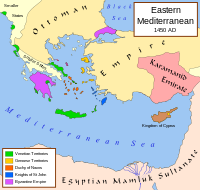Conspiracy of Sifis Vlastos
The Conspiracy of Sifis Vlastos (Greek: Συνομωσία του Σήφη Βλαστού) was a fifteenth-century planned rebellion against the Republic of Venice in the overseas colony of Crete, named after its chief instigator.
Owing to its central location along the trade routes, its size and its products, Crete had a strategic importance for the Venetian rule in the Eastern Mediterranean.
Hoping to receive military assistance from the West, the Byzantine emperor John VIII Palaiologos was eager to form an alliance with the Latin Church.
On the other hand, Pope Eugene IV sent to Crete archbishop Fantino Valaresso as his plenipotentiary, tasked with introducing the reforms needed to implement the union of the churches.
Ecumenical Patriarchs such as Metrophanes II and his successor Gregory III encouraged the union and did not object to the Western involvement in Cretan ecclesiastical affairs, having accepted it as the price for the desperately needed help in confronting the Ottomans.
Their informants were Ioannis Lima, a Cretan priest, and the Venetian Andrea Nigro, who pointed out Sifis Vlastos (Greek: Σήφης Βλαστός) as leader of the conspiracy.
Furthermore, Venetian documents found by Manousos Manousakas mention that the conspirators had forged a letter of support from the Byzantine emperor Constantine XI Palaiologos.
[1] Fearing that if Vlastos and his followers managed to ignite a rebellion, the military forces on Crete would be grossly outnumbered by the Cretans, the Venetian authorities under the Duke of Candia, Benedetto Vitturi, decided to act fast, without first consulting Doge Francesco Foscari.
Thus, with the help of local feudatories, a total of 39 accomplices were arrested, among whom were the priests Manassis Arkoleon and Pavlos Kalyvas, and the civilians Leontakios Troulinos and Georgios Kallergis.
[1] Following the fall of Constantinople and the decline of the Despotate of the Morea, Orthodox priests and monks fled to Crete, strengthening the anti-unionist sentiment there.
Manousakas' research[1] cleared up a long-standing misconception, first made by Andrea Cornaro and adopted by many contemporary historians,[5] according to which Mavrogonatos was involved in the betrayal of Vlastos' conspiracy in 1454.
Realizing the failure of her policies and urged to secure the support of locals in the defense of Crete against the Turks as the Ottoman–Venetian wars broke out, Venice adopted a more sympathetic attitude towards Orthodoxy after the first half of the sixteenth century.


